#lithobates chiricahuensis
Text

Chiricahua Leopard Frog (Lithobates chiricahuensis), family Ranidae, Miller Canyon, Sierra Vista, Arizona, USA
This species has been eliminated from 80% of its native range. It is considered threatened due to habitat loss, introduced species, and the chytrid fungus.
photograph by Joseph Morlan
91 notes
·
View notes
Photo
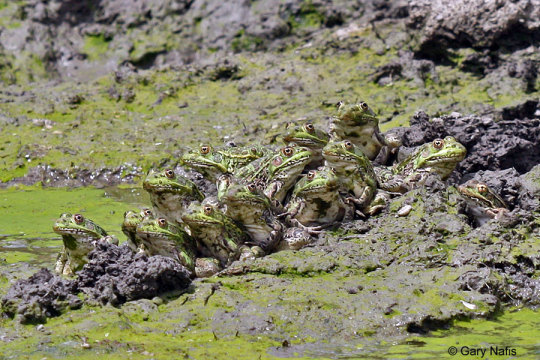

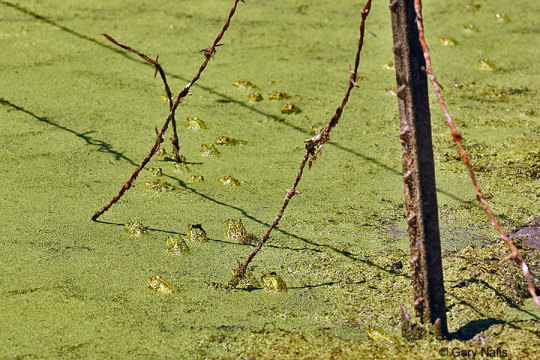
What a splendid day to be a frog! Here we see a group of Chiriacahua leopard frogs [Lithobates chiricahuensis] gathering in a cattle pond in Santa Cruz County, Arizona. Although the pond was almost dry, the frogs were drawn to it following a heavy rain storm the night before. Images by Gary Nafis.
426 notes
·
View notes
Text

today’s funky frog of the day is: lithobates chiricahuensis! commonly known as the chiricahua leopard frog, they are native to mexico and the united states. they inhabit a wide variety of places, including forests, rivers, swamps, lakes, marshes, springs, and ponds. unfortunately, they are threatened by habitat loss as well as a chytrid fungus that has eleminated 80% of their natural habitat. however, efforts are being made to save these frogs. they are large and stocky, and they range from dark green to brown in color. they typically breed and call near water, and eggs are laid in submerged vegetation. they are expected to live 6 years at most, and they have been seen to eat small insects such as crickets.
168 notes
·
View notes
Text
Cool thing: the precarious existence of amphibians in desert ecoregions. Leopard frogs have some surprising biodiversity in the “true” deserts of North America and the American Southwest, including 3 species entirely endemic to the deserts. (Sorry in advance; amphibian biogeography hyperfixation activated.)
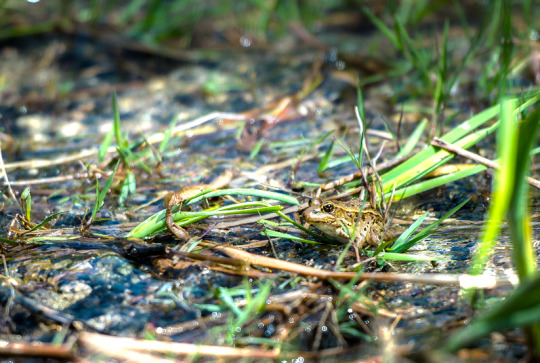
A relict leopard frog, a highly-endangered frog which has a very small distribution range limited only to little wetlands and desert springs near Las Vegas. [Photo by Todd Miller for National Park Service.]
Obviously, chrytid fungus, chemical use in agriculture, development of riparian corridors, and climate change have provoked the widely reported “amphibian apocalypse”; but leopard frogs, especially leopard frogs in the drylands of the American West, have been especially victimized, and there has been severe local extinction, population decline, and habitat loss for leopard frogs living west of the Rockies and in the deserts of the Southwest. Anyway, the presence of these creatures in the desert is interesting to me, because the frogs in the genera Rana/Lithobates are famous to most people living in Europe and North America; they’re the “common” frogs or “pond” frogs or whatever, and they’re usually associated heavily with moisture and water.
There are 3 (formerly 4) distinct species of leopard frog endemic to the true deserts of North America (Mojave, Sonoran, and Chihuahuan desert ecoregions), and they’re all imperiled or endangered in some way, with huge losses in distribution range area in the past few decades. (There are also 2-ish other species of leopard frog living on the periphery of the deserts, though they also live outside of the region and are not endemic.)
1 - Chiricahua leopard frog (Lithobates chiricahuensis)
In the region, the Chircahua leopard frog is sort of, kind of, a little bit like a “Sky Islands species.”

The frog lives in the “temperate sierra” of the Arizona-New Mexico mountain spine, with Mogollon Rim at its northern edge; the frog also lives along the corridor of pine-oak woodlands in the Sky Islands and along the mountains of the Madrean Archipelago. It’s the same ecological corridor of pine-oak habitat associated with distribution range of charismatic animals like ocelots and jaguars. A lot of iconic species, like ridge-nosed rattlesnakes and the now-extinct imperial woodpecker, have distribution ranges completely limited to the Sky Islands and pine-oak corridor.
Here’s a map of the northern Sky Islands populations, at the ecological border between the Sonoran and Chihuahuan deserts, righteously appropriated from US FWS:

And here’s the wider distribution of the species (follows the corridor of pine-oak woodlands along the crest of Sierra Madre Occidental):

A map of recent loss of distribution range, from Reptiles of AZ:
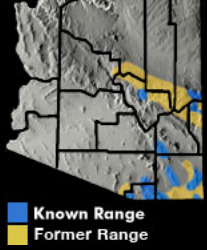
-----
2 - Lowland leopard frog (Lithobates yavapaiensis)

The lowland leopard frog lives along lower slopes of the temperate sierra and along riparian corridors, including the lower Colorado River.

The frog is actually now, apparently, extinct in some of the riparian corridors of the Gila and lower Colorado.
Another distribution map for the species, showing recent habitat loss, from Reptiles of AZ:

-----
3 - Relict leopard frog (Lithobates onca)
And then there’s the critically endangered and aptly-named relict leopard frog, which lives in a very limited range in a narrow corridor between Lake Mohave and St. George (Utah), very close to Las Vegas. The frog’s habitat exists near the ecological border where the Mojave Desert meets the Colorado River and the western edge of southern Utah’s mountains and many canyons, and it probably originally lived along a small portion of the Colorado River corridor that was mostly destroyed with the damming of Lake Mead.
The frog depends on very small springs, where subterranean water occasionally surfaces and creates little patches of wetland vegetation surrounded by desert or arid steppe.
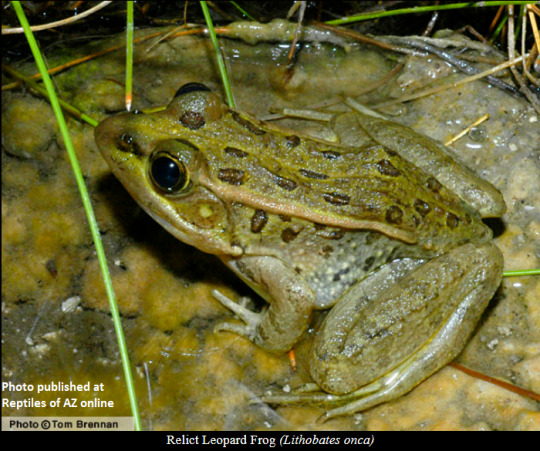
It’s distribution range:
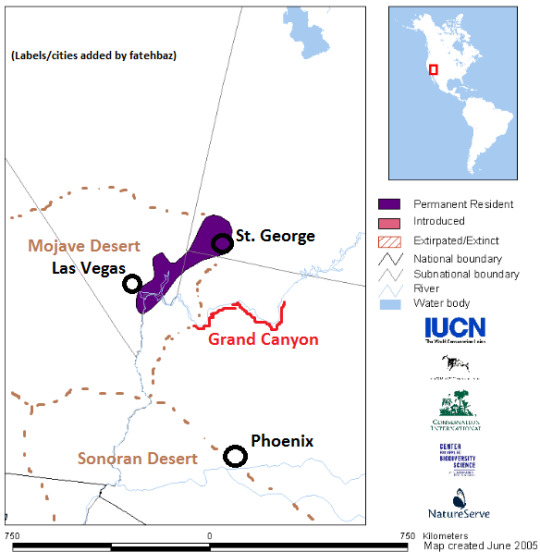
Here’s a closer look at the distribution range and its proximity to Las Vegas:
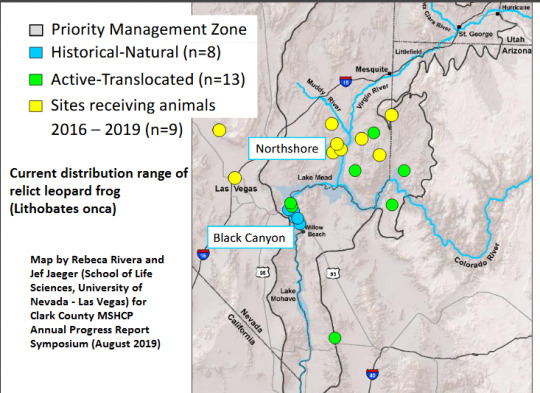
Here’s a look the frog’s habitat:


-----
A 4th species of leopard frog with a small distribution range endemic to the deserts of the Southwest used to be recognized. It was called the “Vegas Valley leopard frog” (Lithobates fisheri) and was thought to have been endemic to the Las Vegas area, and was thought to have gone extinct sometime around the mid-1940s due to the urban development of Las Vegas. But in 2011, newly-reported research showed that the species was actually a population of the Chiricahua leopard frog. (Which is still intriguing, because the closest known populations of Chiricahua leopard frogs live near Phoenix, so the population at Las Vegas was isolated.)
-----
Also in this region, there’s also an introduced population of Rio Grande leopard frogs (Lithobates berlandieri) which now lives in the lower Colorado River area near Yuma and Imperial (California), functionally within the Sonoran Desert ecoregion. The Rio Grande leopard frog is not endemic to the deserts. Though there are native populations of the species in the Chihuahuan Desert, the frog has a much wider distribution; it’s kind of like a subtropical frog mostly associated with Mexico and Central America. Here’s it’s distribution range:

-----
There are some northern leopard frogs living in the area along the northern edge of the Mojave and also in the mountains of northern Arizona and New Mexico. And these northern leopard frogs - though not endemic to the region - are also in danger of localized extinction.
Northern leopard frogs (Lithobates pipiens), which are widely distributed across much of the northern Great Plains, Midwest, and Canada, are famous because they were the ubiqituous “laboratory frog” used in dissection lessons in school classrooms for decades. The northern leopard frog is, itself, critically endangered in its small, isolated, and intermittent populations in dryland environments west of the Continental Divide.
Here’s a map from the Canadian federal government (COSEWIC, after Stebbins 2003 and Smith and Keinath 2007) showing how the northern leopard frog has experienced local extinction in much of the drylands of the inland West:

[The lighter shade of pink/red in the inland west and Pacific Northwest depicts where northern leopard frogs have gone extinct in recent decades, probably due to a combination of chrytid fungus, climate change, and human development of agricultural and riparian landscapes.]
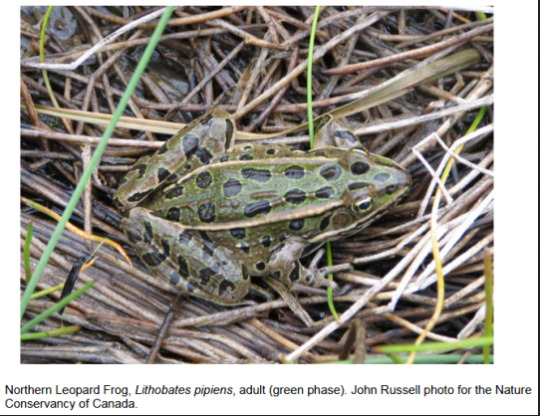
-----
Feel bad for these creatures.
15 notes
·
View notes
Text

Chiricahua Leopard Frog (Lithobates chiricahuensis), family Ranidae, Coconino National Forest, Arizona, USA
This species has been eliminated from 80% of its native range. It is considered threatened due to habitat loss, introduced species, and the chytrid fungus.
photograph by Jim Rorabaugh/USFWS
56 notes
·
View notes
Photo
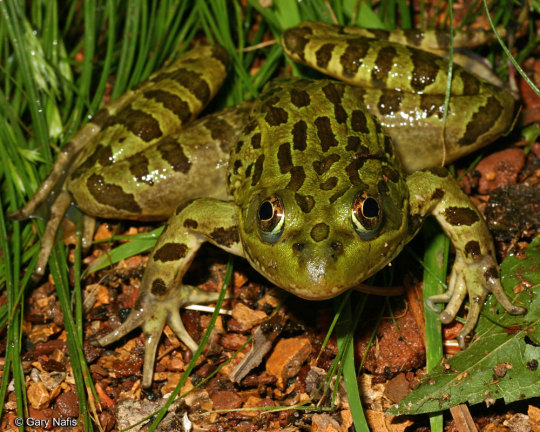

Lithobates chiricahuensis! What do your frog eyes see? Commonly known as Chiriacahua leopard frogs, this southwestern species is severely threatened by habitat loss. Their natural range has been reduced 80% due to human activity. The Phoenix Zoo currently has a captive breeding program in place for these frogs; you can donate to zoo here. Images by Californiaherps.com.
195 notes
·
View notes
Photo
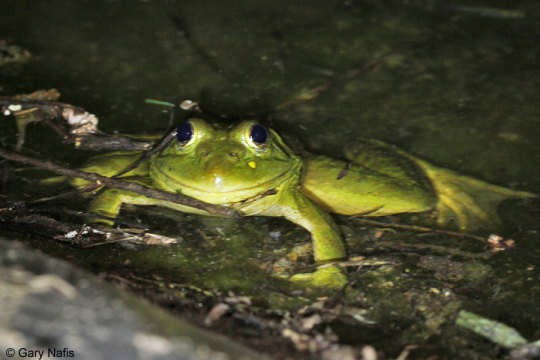

These funny guys are Chiricahua leopard frogs [Lithobates chiricahuensis, synonymous with Rana chiricahuensis], a species native to Mexico as well as parts of the US. They are severely threatened by habitat loss, having lost an estimated 80% of their previous range due to human activity. Captive breeding efforts are currently underway at the Phoenix Zoo; you can donate to the zoo here. Images by Californiaherps.com.
147 notes
·
View notes